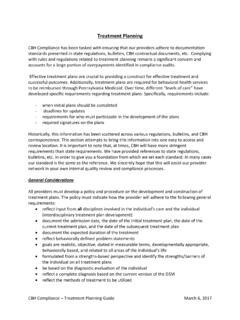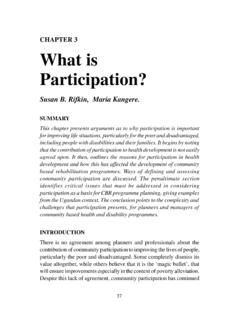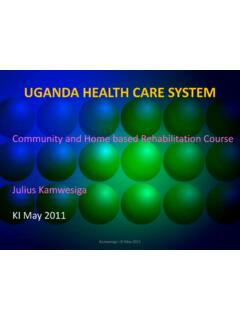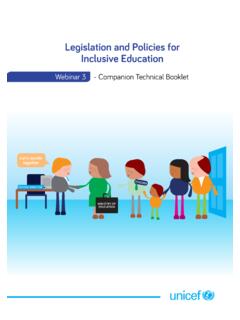Transcription of Improving social inclusion and empowerment for people with ...
1 1 Improving social inclusion and empowerment for people with disabilities in low- and middle-income countries: why does it matter and what works? Howard White (Campbell Collaboration), Ashrita Saran (Campbell Collaboration), and Hannah Kuper (ICED) Why does disability matter? There are an estimated 1 billion people ( including 150 million children) with disabilities That means that, on average, one in seven people and one in 20 children has disabilities. Do people with disabilities lack social inclusion and empowerment ? people with disabilities living in low- and middle-income countries (LMICs)
2 Face widespread social , 2 For instance, adults with disabilities living in India, Cameroon, and Guatemala are less likely to be married and face barriers in taking part in social , community , and civic life compared with their non-disabled , 3 empowerment relates to people with disabilities having a voice, taking control over their own lives, and advocating for their rights and The limited evidence available suggests that people with disabilities face many barriers in this sphere, such as political Which barriers to social inclusion and empowerment do people with disabilities face?
3 Barriers to social inclusion and empowerment for people with disabilities include physical barriers (including inaccessible transport and buildings), information barriers (including lack of sign language interpretation at meetings), system/institutional-level barriers (including lack of policies and legislation requiring that cultural events are accessible), and stigmatising attitudes. Effective interventions aiming to achieve better social inclusion and empowerment for people with disabilities must help overcome these barriers. Why does social exclusion and lack of empowerment matter for people with disabilities?
4 2 Everyone has the right to social inclusion and empowerment , including people with disabilities. These rights are specifically laid out in the UN Convention on the Rights of Persons with Disabilities (UNCRPD).1 E xclusion is therefore a violation of rights. social exclusion and lack of empowerment are also development issues. The Sustainable Development Goal (SDG) 10 includes a call to empower and promote the social , economic and political inclusion of all. A ppropriate and successful inclusive development programmes cannot be established without the central involvement of people with disabilities.
5 What works to improve social inclusion and empowerment for people with disabilities in low- and middle-income settings? We conducted a Rapid Evidence Assessment (REA) to answer this question. We undertook an extensive scoping of the literature, and identified 16 studies that explored what works to improve social inclusion and empowerment for people with disabilities in low- and middle-income 21 What evidence is included in the REA? The REA considered rigorous evidence, limited to randomised controlled trials (RCTs) and systematic reviews, which explored the effectiveness of interventions to improve educational outcomes for people with disabilities in LMICs.
6 Qualitative studies, observational studies, and non-impact evaluations were not included in the review. Findings and recommendations should be understood in this context. We applied quality grading to the literature, so that we could assess where there was strong evidence and where evidence was limited or missing. Emerging findings The following conclusions were reached by the REA: - There was very little evidence available: only 16 studies were identified. All the studies measured improvements in social inclusion , and only two in , 13 - The quality of the evidence was poor: almost all the studies were scored as having low quality, and only two were of moderate , 8 - Most interventions tried to improve the social skills of the person with disabilities, but did not focus on system-level ( policies) or community -level changes.
7 While the quality of the studies was generally low, most showed evidence of impact, including the following: o Vocational training supporting people with disabilities improved measures of social inclusion ( improved perceived acceptance by family members), and empowerment ( likelihood of voting) in o social skills training: programmes were effective at Improving social skills in Malaysia14, Brazil16, and India9. 1 Article 3 of UNCRPD: Respect for inherent dignity, individual autonomy including the freedom to make one s own choices, and independence of persons; Non-discrimination; Full and effective participation and inclusion in society.
8 3 oA school-level intervention which trained teachers using a complexbehavioural intervention called the Good School Toolkit , designed to changethe operational culture of the school, was effective at reducing violenceperpetrated against children with disabilities in rehabilitation (CBR) and other holistic interventionswere effective in Improving social inclusion (for example, friendships) andempowerment (for example, membership of Disabled people s Organisations(DPOs) and village councils) for people with disabilities in , 23 Figure 1 : Map showing the location of studies included in the REA Summary of evidence Various approaches can be used to improve social inclusion and empowerment of people with disabilities.
9 The REA used the World Health Organization CBR matrix as a framework to categorise the different interventions and outcomes considered by the studies available. The table below presents an assessment of the overall evidence in relation to each of these domains. 4 Table 1: Summary of evidence by sub-outcome area social inclusion empowerment General social inclusion Limited evidence Advocacy and communication No evidence Personal assistance No evidence community mobilisation No evidence Relationships, marriage, and family Promising evidence Political participation Limited evidence Culture and arts Limited evidence Membership of Self-Help Groups (SHGs) Limited evidence Recreation and sports Limited evidence Disabled people s Organizations (DPOs)
10 Limited evidence Justice Limited evidence Evidence limitations and gaps - The interventions and outcome measures used by the 16 studies were all different. This meant direct comparison (for example, across countries) was very difficult. The outcomes used were mostly in terms of social skills, rather than social inclusion , and only two explored outcomes related to stigma or , 19 This also meant that most interventions tried to treat the person with disabilities, rather than to address societal reasons for their exclusion and lack of empowerment . - There were additional important evidence gaps: only one study was undertaken in a humanitarian context, and data were lacking on whether outcomes differed by gender and the intersectionality between disability and other characteristics associated with discrimination such as age and ethnicity.













